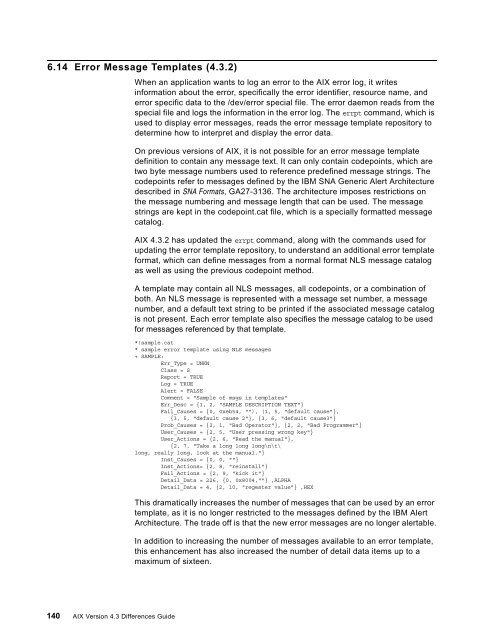AIX Version 4.3 Differences Guide
AIX Version 4.3 Differences Guide
AIX Version 4.3 Differences Guide
Create successful ePaper yourself
Turn your PDF publications into a flip-book with our unique Google optimized e-Paper software.
6.14 Error Message Templates (<strong>4.3</strong>.2)<br />
When an application wants to log an error to the <strong>AIX</strong> error log, it writes<br />
information about the error, specifically the error identifier, resource name, and<br />
error specific data to the /dev/error special file. The error daemon reads from the<br />
special file and logs the information in the error log. The errpt command, which is<br />
used to display error messages, reads the error message template repository to<br />
determine how to interpret and display the error data.<br />
On previous versions of <strong>AIX</strong>, it is not possible for an error message template<br />
definition to contain any message text. It can only contain codepoints, which are<br />
two byte message numbers used to reference predefined message strings. The<br />
codepoints refer to messages defined by the IBM SNA Generic Alert Architecture<br />
described in SNA Formats, GA27-3136. The architecture imposes restrictions on<br />
the message numbering and message length that can be used. The message<br />
strings are kept in the codepoint.cat file, which is a specially formatted message<br />
catalog.<br />
<strong>AIX</strong> <strong>4.3</strong>.2 has updated the errpt command, along with the commands used for<br />
updating the error template repository, to understand an additional error template<br />
format, which can define messages from a normal format NLS message catalog<br />
as well as using the previous codepoint method.<br />
A template may contain all NLS messages, all codepoints, or a combination of<br />
both. An NLS message is represented with a message set number, a message<br />
number, and a default text string to be printed if the associated message catalog<br />
is not present. Each error template also specifies the message catalog to be used<br />
for messages referenced by that template.<br />
*!sample.cat<br />
* sample error template using NLS messages<br />
+ SAMPLE:<br />
Err_Type = UNKN<br />
Class = S<br />
Report = TRUE<br />
Log = TRUE<br />
Alert = FALSE<br />
Comment = "Sample of msgs in templates"<br />
Err_Desc = {1, 2, "SAMPLE DESCRIPTION TEXT"}<br />
Fail_Causes = {0, 0xeb54, ""), (1, 5, "default cause"},<br />
{3, 5, "default cause 2"}, {3, 6, "default cause3"}<br />
Prob_Causes = {2, 1, "Bad Operator"}, {2, 2, "Bad Programmer"}<br />
User_Causes = {2, 5, "User pressing wrong key"}<br />
User_Actions = {2, 6, "Read the manual"},<br />
{2, 7, "Take a long long long\n\t\<br />
long, really long, look at the manual."}<br />
Inst_Causes = {0, 0, ""}<br />
Inst_Actions= {2, 8, "reinstall"}<br />
Fail_Actions = {2, 9, "kick it"}<br />
Detail_Data = 226, {0, 0x8004,""} ,ALPHA<br />
Detail_Data = 4, {2, 10, "regester value"} ,HEX<br />
This dramatically increases the number of messages that can be used by an error<br />
template, as it is no longer restricted to the messages defined by the IBM Alert<br />
Architecture. The trade off is that the new error messages are no longer alertable.<br />
In addition to increasing the number of messages available to an error template,<br />
this enhancement has also increased the number of detail data items up to a<br />
maximum of sixteen.<br />
140 <strong>AIX</strong> <strong>Version</strong> <strong>4.3</strong> <strong>Differences</strong> <strong>Guide</strong>
















